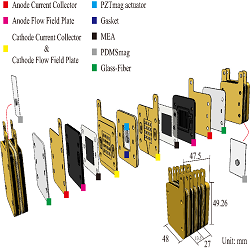
Yuan-Lung Hsu
National Taiwan University, Taiwan
Title: Development of a Bi-Cell proton exchange membrane fuel cell with optimized groovedesigned piezoelectric actuator
Biography
Biography: Yuan-Lung Hsu
Abstract
This study develops an air-breathing pump driven by a piezoelectric actuator to provide oxygen for a proton exchange membrane fuel cell (PEMFC) stack. A groove-designed PZT actuator enclosed with poly-di-methyl-siloxane (PDMS) can reduce uneven air feeding. This actuator can also improve the performance of both sides of a bi-cell, with only a 0.7% difference in the open-circuit voltage under the PZT actuator within a PDMS diaphragm (PZT-PDMS combination) with 30 min curing time, one side of the single cell had an open-circuit voltage of 0.989 V. We combined the permanent magnets with piezoelectric actuator. As the result, the three air-breathing pumps of the bi-cell stack are driven by only one piezoelectric actuator through the magnetic force between magnets. The design of the bi-cell stack enables the air-breathing pump to provide sufficient oxygen for both single cells simultaneously. According to the analysis of computational fluid dynamics, when the nozzle and diffuser of the air-breathing pump have aspect ratio 13.13, diffuser angle (θ) of 15°, and channel opening width (D) of 1.0 mm, the air flow uniformly distribute over inside of the pump, and then it helps stable reaction between oxygen and membrane electrode assembly (MEA). This aspect ratio is chosen to apply on the stack. When both the PZTmag and the PDMSmag used a magnet with a 6 mm diameter and 1 mm thinness, the maximum amplitude of 87 μm was produced under operating conditions of 70 Hz and 40 Vrms, and the power consumption was 0.03 W. The resulting maximum net power density of the bi-cell PZTmag–PEMFC stack was 0.1925 W cm-2, the proposed PEMFC has a net power density that is 20% more than that of a three bi-cell PZT-PEMFC reported in previous research (Ma, 2013), with 68% and 76% less volume and weight, respectively.

Figure 1: The schematic of the Bi-cell PZTmag-PEMFC stack.
Recent Publication:
1. D. Fuard, T. Tzvetkova-Chevolleau, S. Decossas, P. Tracqui, P. Schiavone (2008) Optimization of poly-di-methyl-siloxane (PDMS) substrates for studying cellular adhesion and motility. Microelectronic Engineering 85:1289-1293.
2. A. Ullmann (1998) The piezoelectric valve-less pump—performance enhancement analysis. Sens. Actuators A: Phys. 69:97-105.
3. H.K. Ma, S.H. Huang, B.R. Chen, L.W. Cheng, J (2008) Numerical study of a novel micro-diaphragm flow channel with piezoelectric device for proton exchange membrane fuel cells. Power Sources 180:402-409.
4. H.K. Ma, S.H. Huang, J.S. Wang, C.G. Hou, C.C. Yu, B.R. Chen, J (2010) Experimental study of a novel piezoelectric proton exchange membrane fuel cell with nozzle and diffuser. Power Sources 195:1393-1400.
5. H.K. Ma, H.M. Cheng, W.Y. Cheng, F.M. Fang, W.F. Luo, J (2013) Development of a piezoelectric proton exchange membrane fuel cell stack (PZT-Stack). Power Sources 240:314-322.

